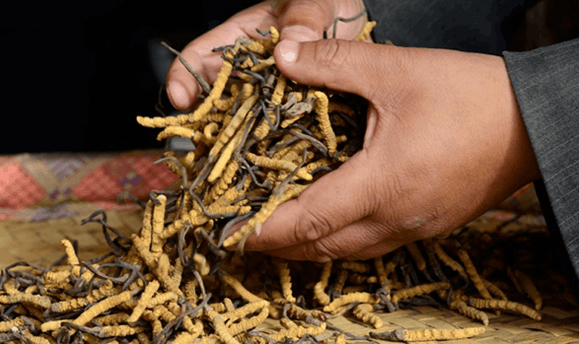
The Process
Handcrafted Sustainable Luxury
It is self-gratifying despite the drudgery because the final product is impeccably sophisticated, but to be able to churn out such a product takes a lot of expertise, keenness, patience, and diligence.From the rigorous hand-picking course in an altitude above 3000 meters to drying, grounding, extracting, mixing, and fermenting; every process is scrutinized meticulously and skillfully to give out a well-balanced product leveraging on medicinal herbs and modern science. The first of its kind, Yarchagumba Beverage intends to leave no stones unturned to give you a legacy and taste that hails from the Himalayas.
About Yarcha
Yarchagumba Heritage
Ophiocordyceps sinensis (formerly known as Cordyceps sinensis) is known in English colloquially as caterpillar fungus. In Nepal they are called Yarcha-gumba, (Nepali: ) or Keeda Jadi. It is an entomopathogenic fungus (a fungus that grows on insects) in the family of Ophiocordycipitaceae It is mainly found in the meadows above 3,500 meters (11,483 feet) on Himalayan regions of Nepal and Bhutan and Tibetan Plateau in Southwest China. The use of caterpillar fungus as folk medicine apparently originated in Nepal and Tibet. So far the oldest known text documenting its use was written in the late 15th century by the Tibetan doctor Zurkhar Nyamnyi Dorje (1439-1475), where he describes its use as an aphrodisiac.

The first mention of Ophiocordyceps sinensis in traditional Chinese medicine was in Wang Ang’s 1694 compendium of materia medica. In the 18th century it was listed in Wu Yiluo's ("New compilation of materia medica"). The ethno-mycological knowledge on caterpillar fungus among the Nepalese people is documented. The entire fungus-caterpillar combination is hand-collected for medicinal use.
In traditional Chinese medicine, it is regarded as having an excellent balance of yin and yang as it is considered to be composed of both an animal and a vegetable. They are now cultivated on an industrial scale for their use in traditional Chinese medicine. However, no one has succeeded so far in rearing the fungus by infecting cultivated caterpillars; all products derived from cultured Ophiocordyceps are derived from mycelia grown on grains or in liquids. The compound cordycepin, a derivative of the nucleoside adenosine, is found in caterpillar fungus as well as other Cordyceps species. Cordycepin has several potential medicinal and therapeutic applications, it has also displayed cytotoxicity against some leukemic cells in vitro. At least one clinical trial of cordycepin as a leukemia treatment is in progress. Other in vitro studies have demonstrated that cultured Cordyceps sinesis extracts exhibited anti-inflammatory and anti-fibrotic cellular responses.
Citation:https://en.wikipedia.org/wiki/Ophiocordyceps_sinensis